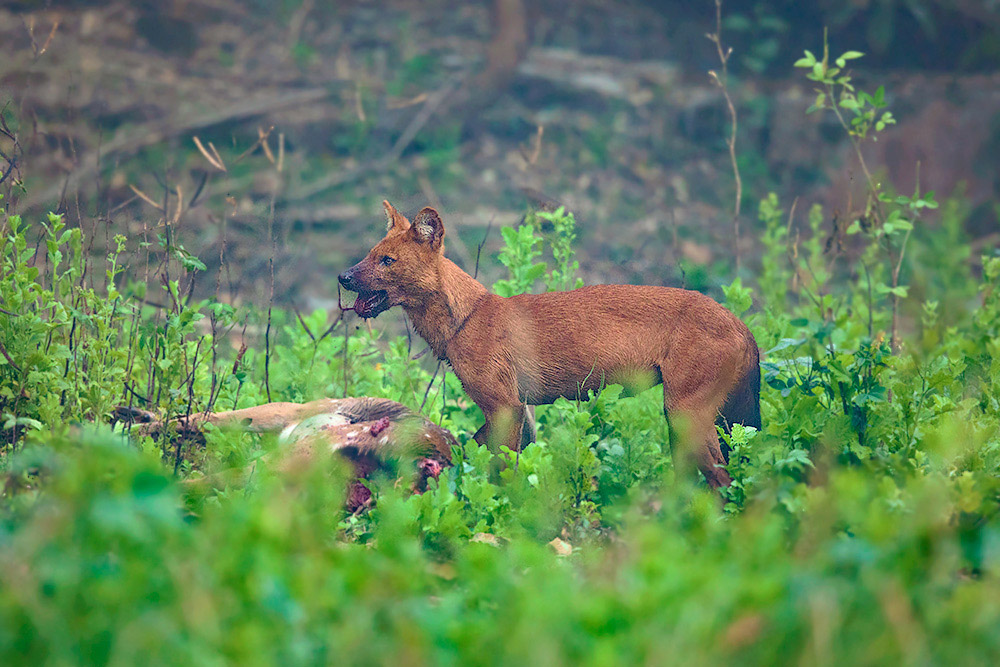India hosts a wide diversity of carnivores in a relatively small fraction of the global land area. Unfortunately, a lot of these carnivores are at risk of extinction with barely any information on their populations, nor methods available to monitor them. The Asiatic wild dog or dhole (cuon alpinus) ranks among the most threatened carnivores in the world. Till date, monitoring their populations has proven to be a challenge because dholes do not have visible distinguishing features such as stripes or spots on their pelage. Informed guesstimates suggest that there may be 1000–2000 adult, mature dholes left globally, with India hosting the largest population. In a first for the species, a recent study by scientists from Wildlife Conservation Society–India (WCS-India), National Centre for Biological Sciences (NCBS), University of Florida, Kerala Veterinary and Animal Sciences University, and Stanford University assessed population size and density of the dhole in Wayanad Wildlife Sanctuary, in the Western Ghats of Kerala.
As part of the study, the scientists collected dhole scats (fecal droppings) by conducting field surveys across 350 sq. km of the sanctuary. They extracted DNA from the scats and used a molecular approach involving ‘Single Nucleotide Polymorphisms’ or SNPs to identify unique dhole individuals. Scats contain information on different individuals in the form of DNA, and SNPs help in identification of individuals from DNA. Combining this information with sophisticated statistical methods called Spatial Capture–Recapture models, the researchers were able estimate dhole numbers and map their density across the sanctuary.
Results from the research showed that Wayanad had high densities of dhole at around 12–14 individuals per 100 sq. km, and approximately 50 individuals within the sanctuary limits. Higher spatial densities of dholes were associated with lower elevation areas and drier, rugged parts of the sanctuary that likely reflect regions with high prey density. Notably, Wayanad also harbors high densities of tigers (11–12 individuals per 100 sq. km as per recent countrywide estimates), indicating that these two endangered large predators can co-exist at relatively high densities under ideal conditions of adequate prey numbers, good habitat quality and active protection measures.
With consistent historical decline in populations across their range, there is a need for targeted assessments of dhole populations to inform conservation actions and plans for the species. Overall, the new study suggests that Wayanad Wildlife Sanctuary (in conjunction with neighbouring well protected forests) functions as a local stronghold for dhole populations in the Western Ghats. The widespread adoption of the methods developed as part of this study and the scaling up across critical landscapes (Western Ghats, Central India and Northeast India) would help initiate monitoring efforts and planning conservation actions targeted at dholes.
Citation: Srivathsa, A., Rodrigues, R. G., Toh, K. B., Taylor, R. W., Zachariah, A., Oli, M. K., Ramakrishnan, U. (2021). The truth about scats and dogs: Next-generation sequencing and spatial capture–recapture models offer opportunities for conservation monitoring of an endangered social canid. Biological Conservation, 256, 109028. doi: 10.1016/j.biocon.2021.109028


 CI is a non-profit, non-commercial portal that aims to facilitate wildlife and nature conservation by providing reliable information and the tools needed to campaign effectively.
CI is a non-profit, non-commercial portal that aims to facilitate wildlife and nature conservation by providing reliable information and the tools needed to campaign effectively.